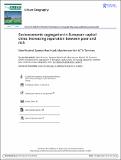Socioeconomic segregation in European capital cities. Increasing separation between poor and rich
Abstract
Socioeconomic inequality is on the rise in major European cities, as are concerns over it, since it is seen as a threat to social cohesion and stability. Surprisingly, relatively little is known about the spatial dimensions of rising socioeconomic inequality. This paper builds on a study of socioeconomic segregation in 12 European cities: Amsterdam, Athens, Budapest, London, Madrid, Oslo, Prague, Riga, Stockholm, Tallinn, Vienna, and Vilnius. Data used derive from national censuses and registers for 2001 and 2011. The main conclusion is that socioeconomic segregation has increased. This paper develops a rigorous multifactor approach to understand segregation and links it to four underlying, partially overlapping, structural factors: social inequalities, globalization and economic restructuring, welfare regimes, and housing systems. Taking into account contextual factors resulted in a better understanding of actual segregation levels, while introducing time lags between structural factors and segregation outcomes will likely further improve the theoretical model.
Citation
Musterd , S , Marcińczak , S , Ham , M V & Tammaru , T 2017 , ' Socioeconomic segregation in European capital cities. Increasing separation between poor and rich ' , Urban Geography , vol. 38 , no. 7 , pp. 1062-1083 . https://doi.org/10.1080/02723638.2016.1228371
Publication
Urban Geography
Status
Peer reviewed
ISSN
0272-3638Type
Journal article
Description
The research leading to this paper has received funding from the Estonian Research Council (Institutional Research Grant IUT no. 2–17 on Spatial Population Mobility and Geographical Changes in Urban Regions); European Research Council under the European Union’s Seventh Framework Programme (FP/2007-2013) /ERC Grant Agreement no. 615159 (ERC Consolidator Grant DEPRIVEDHOODS, Socio-spatial Inequality, Deprived Neighborhoods, and Neighborhood Effects); and from the Marie Curie programme under the European Union’s Seventh Framework Programme (FP/2007-2013) /Career Integration Grant no. PCIG10-GA-2011-303728 (CIG Grant NBHCHOICE, Neighborhood Choice, Neighborhood Sorting, and Neighborhood Effects); and direct funding from the Universities of Amsterdam and Lodz.Collections
Items in the St Andrews Research Repository are protected by copyright, with all rights reserved, unless otherwise indicated.

